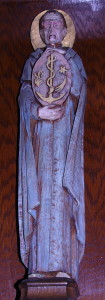 Saint John Bosco (August 16, 1815 – January 31, 1888), born Giovanni Melchiorre Bosco, also called Don Bosco, was an Italian Catholic priest and educator who put into practice the dogma of his religion, employing teaching methods based on love rather than punishment. He placed himself under the protection of Francis de Sales (thus his followers styled themselves the Salesian Society) and succeeded in establishing a network of centers to carry on his ministry. In recognition of his work with disadvantaged youth, he was canonized by Pope Pius XI in 1934. John Bosco was born in Becchi, Piedmont. Early in his childhood he had a vision in which he learned what his life would be dedicated to; in the dream he heard a voice which said, “Not with blows, but with charity and gentleness must you draw these friends to the path of virtue.” Don Bosco began as the chaplain of the Rifugio (“Refuge”), a girls’ boarding school in Turin, but he had many other ministries, such as visiting prisoners, teaching catechism and helping out at country parishes. He slowly organized his helpers into a loose “Congregation of St. Francis de Sales” while also training select older boys for the priesthood. In 1859, Bosco selected an experienced priest, fifteen seminarians and one high school boy and formed them into the Society of St. Francis de Sales. This was the nucleus of the Salesians, the religious order that would carry on his work. When he died, thousands attended his funeral, and very soon after there were popular demands to have him canonized. Bosco was declared Blessed in 1929 and canonized on Easter Sunday of 1934, when he was given the title of “Father and Teacher of Youth.” While Bosco had been popularly known as the patron saint of illusionists, on January 30, 2002, Fr. Silvio Mantelli, SDB, petitioned Pope John Paul II to formally acclaim St John Bosco the Patron of Stage Magicians. Catholic stage magicians venerate Don Bosco by offering free magic shows to underprivileged children on his feast day, January 31.
Saint John Bosco (August 16, 1815 – January 31, 1888), born Giovanni Melchiorre Bosco, also called Don Bosco, was an Italian Catholic priest and educator who put into practice the dogma of his religion, employing teaching methods based on love rather than punishment. He placed himself under the protection of Francis de Sales (thus his followers styled themselves the Salesian Society) and succeeded in establishing a network of centers to carry on his ministry. In recognition of his work with disadvantaged youth, he was canonized by Pope Pius XI in 1934. John Bosco was born in Becchi, Piedmont. Early in his childhood he had a vision in which he learned what his life would be dedicated to; in the dream he heard a voice which said, “Not with blows, but with charity and gentleness must you draw these friends to the path of virtue.” Don Bosco began as the chaplain of the Rifugio (“Refuge”), a girls’ boarding school in Turin, but he had many other ministries, such as visiting prisoners, teaching catechism and helping out at country parishes. He slowly organized his helpers into a loose “Congregation of St. Francis de Sales” while also training select older boys for the priesthood. In 1859, Bosco selected an experienced priest, fifteen seminarians and one high school boy and formed them into the Society of St. Francis de Sales. This was the nucleus of the Salesians, the religious order that would carry on his work. When he died, thousands attended his funeral, and very soon after there were popular demands to have him canonized. Bosco was declared Blessed in 1929 and canonized on Easter Sunday of 1934, when he was given the title of “Father and Teacher of Youth.” While Bosco had been popularly known as the patron saint of illusionists, on January 30, 2002, Fr. Silvio Mantelli, SDB, petitioned Pope John Paul II to formally acclaim St John Bosco the Patron of Stage Magicians. Catholic stage magicians venerate Don Bosco by offering free magic shows to underprivileged children on his feast day, January 31.
< Back to History of the Reredos
